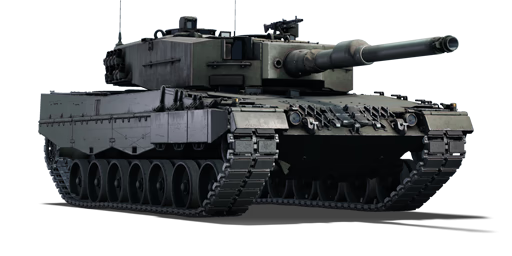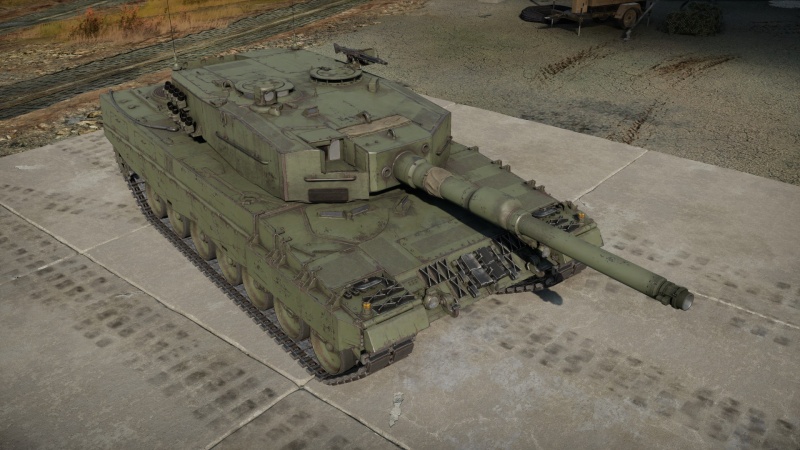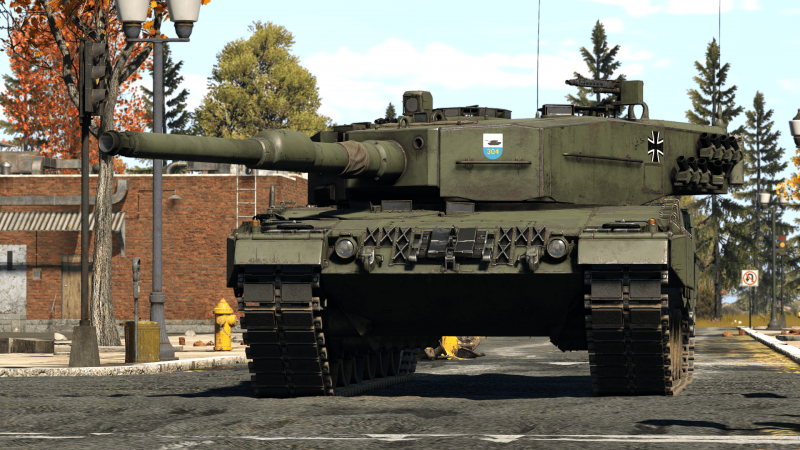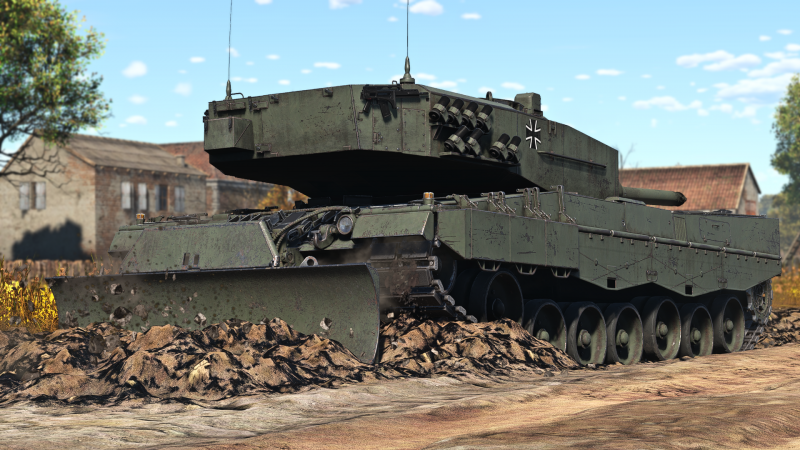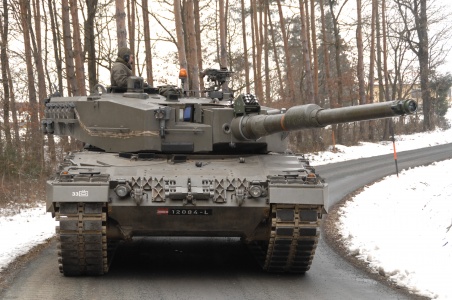Leopard 2A4
| This page is about the German medium tank Leopard 2A4. For other versions, see Leopard 2 (Family). |
Contents
Description
The Leopard 2A4 is the fifth variant of the Leopard 2 main battle tank family. The Leopard 2A4 is the most iconic variant, with numerous changes and upgrades over the preceding variants. By far the most popular variant, with over 1,800 units built in eight batches between 1985 and 1992, it surpassed every other variant in numbers. The Leopard 2A4 variant saw multiple significant upgrades, including an automatic fire and explosion suppression system, an all-digital fire control system capable of handling new ammunition types, and an upgraded turret with flat titanium/tungsten armour. All previous variants were later upgraded to Leopard 2A4 standards as well. Until 1994, Germany had 2,125 Leopard 2A4 units (695 new and the rest upgraded older variants), while the Netherlands had an additional 445 units. It was also produced in Switzerland under license. After the Cold War ended, Germany and the Netherlands found themselves with large inventories of tanks they no longer needed. These tanks were sold to nations all around the world. This is why it is the most well-known and widely used variant, and various modernisation packages and programs have been developed for it in recent years.
Introduced in Update 1.79 "Project X", the Leopard 2A4 is an exceptionally distinctive tank design that evolved from the previous Leopard 1 main battle tank physiology, which prioritized mobility over armor protection. The Leopard 2A4 has substantially better protection thanks to the use of composite armour in both the hull and the turret, while still remaining within acceptable weight limitations. Composite armour is a type of vehicle armour made up of layers of various materials such as metals, polymers, ceramics, or air. Most composite armours are lighter than their all-metal counterparts, resulting in less weight while providing the same amount of protection. With its legendary 120 mm Rheinmetall L/44 tank gun, the Leopard 2A4 sets an example for modern main battle tanks, flawlessly balancing protection, mobility, and firepower.
General info
Survivability and armour
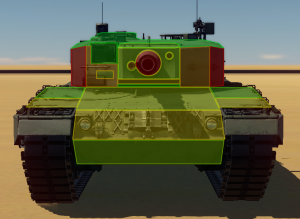
The Leopard 2A4's kinetic protection is reasonable, with the turret cheeks near-invulnerable to all but the most powerful rounds (e.g. CL3143) and the upper front plate capable of protecting against less powerful rounds (e.g. M735) - however besides these sections the remainder of the vehicle is largely vulnerable to high-powered kinetic rounds; of note are the weak lower front plate and the gun mantlet, both of which are reasonably visible targets, as well as the gunner's optics.
The vehicle sports significantly better all-round chemical protection, with an upper hull and turret essentially immune to all but the most powerful ATGMs frontally, with upwards of 800mm worth of equivalent protection in places. Despite this, it's advisable to be wary of incoming ATGMs as a well-placed round may sneak past the heavily protected areas - and some missiles such as those of the ADATS will slice straight through even the turret cheeks.
As with most other MBTs, the 2A4 is particularly vulnerable from the sides and back.
The Leopard 2A4 is reasonably survivable, with some degree of crew spacing. However, from certain angles, the crew are placed in a straight line and successful penetration may impact three of the four crew members, resulting in a crew knock-out. In addition, well-placed side shots may impact all three turret crew members.
Ammunition is stored in the primary ammunition storage in the rear of the turret, or in the secondary storage next to the driver. The primary rack provides crew protection through the use of blow-out panels, however only has space for 15 rounds. When more than 16 rounds are taken to battle, ammunition will be stored in the significantly more vulnerable hull rack.
The Leopard 2A4's protection proves acceptable for long-range combat, although it's ill-advised to remain in one location for any extended period of time to avoid opposing vehicles being able to hone their shots onto your weak spots. The 2A4's protection should not be relied upon in urban or other close-range environments.
Armour type:
- Rolled homogeneous armour (hull sides, rear, and roof, turret sides, rear, and roof)
- High hardness rolled armour (hull front, turret front, gun mantlet)
- Cast homogeneous armour (gun mantlet frame)
- Composite screen (front side skirts)
- Structural stell (rear side skirts)
| Armour | Front (Slope angle) | Sides | Rear | Roof |
|---|---|---|---|---|
| Hull | 35 mm (53-82°) Upper glacis 40 mm (51°) Lower glacis 30 mm (82°) Driver's hatch |
10 mm (5°) Upper hull 35 mm Lower forward hull 20 mm Lower rear hull 5 mm Side Skirts 100 mm Composite screening |
20 mm (11°) Upper plate 20 mm (17°) Lower plate 20 mm (50°) Lower glacis |
35 mm (8°) Front glacis 20 mm (0-8°) Hull sides and engine deck 5 mm Engine vents |
| Turret | 35 mm (32-44°) Cheeks incl. Gunner optics 120+16 mm Mantlet |
35 mm Forward 15 mm Rear |
10+25 mm (10°) Basket 20 mm (70°) Turret underside |
40 mm (82-85°) Forward centre 14 mm (72-77°) Forward sides 20 mm Rear incl. cupolas |
| Composite armour | Front | Sides |
|---|---|---|
| Hull | Upper + Lower glacis 90 - 350 mm Kinetic 243 - 600 mm Chemical |
|
| Turret | Turret cheeks 420 - 800 mm Kinetic 535 - 820 mm Chemical Gun mantlet 100 - 270 mm Kinetic 300 - 480 mm Chemical |
Side armour 194 - 260 mm Kinetic 280 - 400 mm Chemical |
Notes:
- Suspension wheels, tracks, and torsion bars are 20 mm thick.
Mobility
| Game Mode | Max Speed (km/h) | Weight (tons) | Engine power (horsepower) | Power-to-weight ratio (hp/ton) | |||
|---|---|---|---|---|---|---|---|
| Forward | Reverse | Stock | Upgraded | Stock | Upgraded | ||
| Arcade | 76 | 35 | 55.2 | 2,032 | 2,862 | 36.81 | 51.85 |
| Realistic | 69 | 31 | 1,327 | 1,500 | 24.04 | 27.17 | |
The Leopard 2A4 is powered by an MTU MB 873 Ka-501 engine which produces a whopping 1,500 hp (1,100 KW), resulting in a power-to-weight ratio of slightly over 27 hp per tonne, compared to the ratio of the early Abrams and identical to the T-80U. As such, the Leopard 2A4 is quite mobile despite weighing over 55 tonnes, comfortably able to reach 72 km/h on-road and well capable of keeping up with its competitors. This allows for an active, aggressive playstyle, using the Leopard's high speed and good acceleration characteristics to get into an early flanking position or take early cap points - though it is important to keep in mind that opposition forces might attempt the same.
The Leopard 2A4 has a maximum reverse speed of 31 km/h which it reaches easily, allowing for a quick retreat in sub-optimal situations.
Modifications and economy
The first modifications to research should be Parts, FPE, and the DM13 round. After that, aim for the NVD, DM23, Laser rangefinder, or mobility upgrades, depending on the desired playstyle.
Armaments
Main armament
The famous Rheinmetall L/44 120 mm cannon is mounted as the primary armament on the Leopard 2A4, offering a balance of firepower, accuracy and sustained rate of fire. The 2A4 has three rounds available to it: DM12 HEATFS, DM13 APFSDS and DM23 APFSDS. Of these, only DM12 is available when the vehicle is stock, with DM13 a tier 1 and DM23 a tier 4 modification. The L/44 is reasonably accurate at long range with any ammunition, however minor round deviation may be evident at extreme ranges (over 2,000 m).
It's advisable to primarily rely on the best available APFSDS round for engaging other MBTs, however, retaining a couple of DM12 rounds can prove valuable against lighter vehicles such as the ADATS.
| 120 mm Rh120 L/44 | Turret rotation speed (°/s) | Reloading rate (seconds) | |||||||||||
|---|---|---|---|---|---|---|---|---|---|---|---|---|---|
| Mode | Capacity | Vertical | Horizontal | Stabilizer | Stock | Upgraded | Full | Expert | Aced | Stock | Full | Expert | Aced |
| Arcade | 42 | -9°/+20° | ±180° | Two-plane | 38.1 | 52.7 | 64.0 | 70.8 | 75.3 | 7.80 | 6.90 | 6.36 | 6.00 |
| Realistic | 23.8 | 28.0 | 34.0 | 37.6 | 40.0 | ||||||||
Ammunition
| Penetration statistics | |||||||
|---|---|---|---|---|---|---|---|
| Ammunition | Type of warhead |
Penetration @ 0° Angle of Attack (mm) | |||||
| 10 m | 100 m | 500 m | 1,000 m | 1,500 m | 2,000 m | ||
| DM12 | HEATFS | 480 | 480 | 480 | 480 | 480 | 480 |
| DM13 | APFSDS | 393 | 390 | 384 | 376 | 367 | 359 |
| DM23 | APFSDS | 410 | 408 | 401 | 393 | 384 | 376 |
| Shell details | ||||||||||||
|---|---|---|---|---|---|---|---|---|---|---|---|---|
| Ammunition | Type of warhead |
Velocity (m/s) |
Projectile mass (kg) |
Fuse delay (m) |
Fuse sensitivity (mm) |
Explosive mass (TNT equivalent) (kg) |
Ricochet | |||||
| 0% | 50% | 100% | ||||||||||
| DM12 | HEATFS | 1,140 | 13.5 | 0.05 | 0.1 | 2.15 | 65° | 72° | 77° | |||
| DM13 | APFSDS | 1,650 | 4.44 | - | - | - | 78° | 80° | 81° | |||
| DM23 | APFSDS | 1,640 | 4.3 | - | - | - | 78° | 80° | 81° | |||
Ammo racks
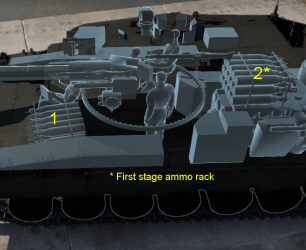
| Full ammo |
1st rack empty |
2nd rack empty |
Visual discrepancy |
|---|---|---|---|
| 42 | 16 (+26) | 1 (+41) | No |
Notes:
- Shells are modeled individually and disappear after having been shot or loaded.
- Rack 2 is a first stage ammo rack located within a blow-out containment
- It totals 15 shells and gets filled first when loading up the tank and emptied first when firing.
- If you pack 16 (+26) shells, it will keep the hull empty of ammo.
- Full reload speed will be realized as long as shells are available in the ready rack 2. If the ready rack is empty, a penalty to reload speed will occur.
- Simply not firing when the gun is loaded will move ammo from rack 1 into rack 2. Firing will interrupt the restocking of the ready rack.
Machine guns
The 2A4 is equipped with one pintle-mounted machine gun and one coaxial machine gun. These can be used as an anti-air deterrent or for clearing out light obstacles and crew from open vehicles.
| 7.62 mm MG3A1 | ||||
|---|---|---|---|---|
| Mount | Capacity (Belt) | Fire rate | Vertical | Horizontal |
| Coaxial | 4,600 (200) | 1,200 | N/A | N/A |
| Pintle | 2,000 (200) | 1,200 | -10°/+75° | ±180° |
Usage in battles
The Leopard 2A4 may feel somewhat sluggish when stock, and the DM12 HEATFS round may appear to be relatively ineffective. Prior to researching improved rounds and engine modifications, it may be wise to play conservatively.
Once the vehicle's modifications are all researched, however, the 2A4 becomes significantly more mobile and has a competitive, albeit not impressive round in the DM23 APFSDS. The 2A4 can be used comfortably in both urban and rural environments, providing the vehicle's weaknesses are kept in mind. While it is capable in most forms of engagement, it does lack the precision of the British Challenger MBTs or the extreme round velocities of the Soviet T-64/T-80 series. The 2A4 also has a particularly large and blocky profile, making for a particularly visible target in many situations.
Considering the above, a Leopard 2A4 player should utilise its great mobility and competitive gun to get into early positions to pick off unsuspecting targets, rather than attempting to engage opposing forces head-on.
Pros and cons
Pros:
- Powerful engine, high top speed and acceleration
- Good neutral steering system
- Good gunner sight magnification for long-range engagements
- Reasonably high-velocity kinetic rounds
- Competent DM23 APFSDS
- Turret armour is mostly effective for hull-down engagements
- Primary ammunition is contained within a storage unit with blow-out panels
- Generation 1 thermals in the gunner sight
Cons:
- Hull armour is mediocre, particularly against kinetic rounds
- The stock DM12 HEATFS round can prove relatively ineffectual when compared to DM13/DM23, particularly against targets with ERA
- The gunner's optics are a weak spot, enemies who know how to aim can cripple your gun and kill your crew
- The gun mantlet is relatively weak while being quite prominent, penetration can disable the gun or knock turret crew out
- The turret cheeks can be penetrated by most APFSDS rounds when hit at the right angle
- Secondary ammunition storage is extremely vulnerable, although this is avoidable by carrying no more than 16 rounds
- Both machine guns are relatively light calibre, suffer from mediocre gun elevation and will not prove to be much more an annoyance to aircraft, particularly helicopters
- Blowout panels are unreliable and have a low capacity
History
Based on the testing results gathered from the various different Leopard 2K prototypes, a new Leopard 2 prototype was constructed that would be more representative of the final version of the vehicle. Designated as Leopard 2AV, the new prototype featured a redesigned hull and turret over the Leopard 2K. Furthermore, the prototype was tested with two different cannons; the British rifled 105 mm L7 and the German 120 mm Rheinmetall L44 smoothbore cannon.
In 1976, the Leopard 2AV was sent overseas to the United States to be comparatively tested against the new American state-of-the-art XM1 Abrams. During testing, the Leopard 2AV proved itself as a good counterpart to the Abrams, outperforming its competitor in terms of fire accuracy, whilst demonstrating somewhat inferior protection and gun handling. Upon arriving back to its homeland with positive testing results, the decision was made to begin mass production of the Leopard 2 in 1977.
The production version Leopard 2, however, differed from the AV prototype in receiving an increased level of protection before mass production began. Mass production of the Leopard 2 started in 1979 with the Leopard 2A0 forming the first batch that would enter service with the German Bundeswehr in late 1979.
Throughout the production period of the early Leopard 2 versions, modernization and upgrades were being applied on the assembly line in order to keep the newest Leopards up to the latest standards. These modernization efforts mostly involved the upgrading of internal modules such as the aiming and communications systems. As a result of this, all early Leopard 2s (A0-A4) were visually neigh identical to each other. The Leopard 2A4 was the final early Leopard 2 variant before the more advanced and heavily upgraded subsequent Leopard 2 versions made their appearance as part of a new wave of modernization efforts.
A total of 695 Leopard 2A4s were built out of the total of 2.125 early Leopard 2s that were manufactured between 1979 - 1991. The Leopard 2 and its variants served primarily with the German Bundeswehr, but a number of export vehicles were sold to nations world-wide, ranging from Canada and Chile, over Denmark and Austria to Greece and Turkey to name a few.
-From Devblog
Media
- Skins
- Photos
- Videos
See also
- Related development
External links
| Krauss-Maffei Wegmann (KMW) | |
|---|---|
| MBTs | |
| Leopard 1 | Leopard I · Leopard A1A1 · Leopard A1A1 (L/44) · Leopard 1A5 · C2A1 |
| Leopard 2 | PT-16/T14 mod. · Leopard 2K · Leopard 2A4 · Leopard 2 (PzBtl 123) · Leopard 2 PL · Leopard 2A5 · Leopard 2A6 |
| KPz-70 | KPz-70* |
| *By the Deutsche Entwicklungsgesellschaft consortium, in collaboration with the General Motors Company. | |
| IFVs | PUMA |
| SPAAs | Gepard · Gepard 1A2 |
| Export | |
| Leopard 1 | ▄Leopard 1A5 · Leopard 1A5NO2 |
| Leopard 2 | Strv 121 |
| See Also | BAE Systems AB |
| Germany medium tanks | |
|---|---|
| Pz.III | Pz.III B · Pz.III E · Pz.III F · Pz.III J · Pz.III J1 · Pz.III J1 TD · Pz.III L · Pz.III M · Pz.III N |
| Pz.IV | Pz.IV C · Pz.IV E · Pz.IV F1 · Pz.IV F2 · Pz.IV G · Pz.IV H · Pz.IV J · Pz.Bef.Wg.IV J |
| Pz.V | VK 3002 (M) · Panther A · Panther D · Panther F · Panther G · Ersatz M10 · Panther II |
| M48 upgrades | M48A2 G A2 · M48 Super |
| Leopard 1 | Leopard I · Leopard A1A1 · Leopard A1A1 (L/44) · Leopard 1A5 · C2A1 · Turm III |
| Leopard 2 | PT-16/T14 mod. · Leopard 2K · Leopard 2AV |
| Leopard 2A4 · Leopard 2 (PzBtl 123) · Leopard 2 PL · Leopard 2A5 · Leopard 2 PSO · Leopard 2A6 · Leopard 2A7V | |
| Trophies | ▀M4 748 (a) · ▀T 34 747 (r) |
| Other | Nb.Fz. · KPz-70 |
| USA | mKPz M47 G · M48A2 C |
| USSR | ◊T-72M1 |


